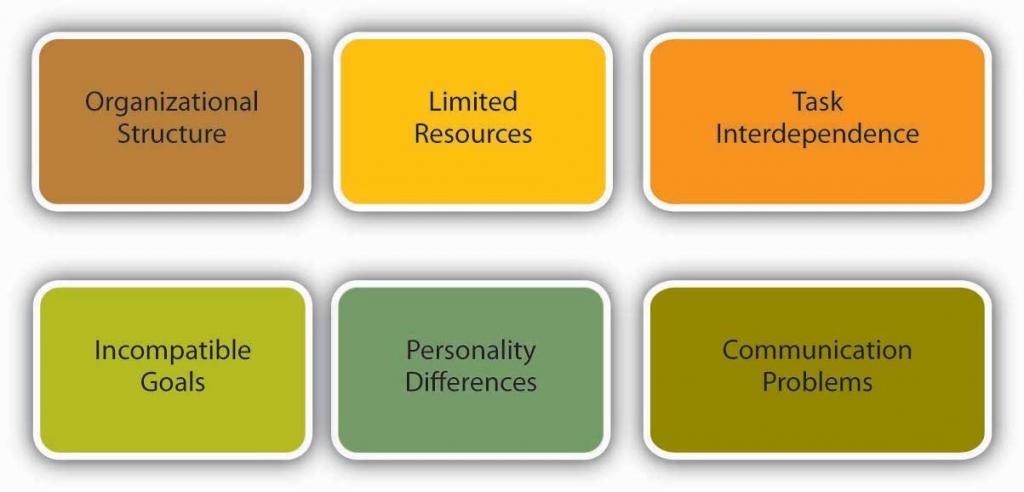10.3: Causes and Outcomes of Conflict
- Page ID
- 4687
Learning Objectives
- Understand different causes of conflict.
- Understand jobs at risk for conflict.
- Learn the outcomes of conflict.
There are many potential root causes of conflict at work. We’ll go over six of them here. Remember, anything that leads to a disagreement can be a cause of conflict. Although conflict is common to organizations, some organizations have more than others.
Figure 10.5 Potential Causes of Conflict

Causes of Conflict
Organizational Structure
Conflict tends to take different forms, depending upon the organizational structure (Jaffe, 2000). For example, if a company uses a matrix
structure as its organizational form, it will have decisional conflict built in, because the structure specifies that each manager report to two bosses. For example, global company ABB Inc. is organized around a matrix structure based on the dimensions of country and industry. This structure can lead to confusion as the company is divided geographically into 1,200 different units and by industry into 50 different units (Taylor, 1991).
Limited Resources
Resources such as money, time, and equipment are often scarce. Competition among people or departments for limited resources is a frequent cause for conflict. For example, cutting-edge laptops and gadgets such as a BlackBerry or iPhone are expensive resources that may be allocated to employees on a need-to-have basis in some companies. When a group of employees have access to such resources while others do not, conflict may arise among employees or between employees and management. While technical employees may feel that these devices are crucial to their productivity, employees with customer contact such as sales representatives may make the point that these devices are important for them to make a good impression to clients. Because important resources are often limited, this is one source of conflict many companies have to live with.
Task Interdependence
Another cause of conflict is task interdependence; that is, when accomplishment of your goal requires reliance on others to perform their tasks. For example, if you’re tasked with creating advertising for your product, you’re dependent on the creative team to design the words and layout, the photographer or videographer to create the visuals, the media buyer to purchase the advertising space, and so on. The completion of your goal (airing or publishing your ad) is dependent on others.
Incompatible Goals
Sometimes conflict arises when two parties think that their goals are mutually exclusive. Within an organization, incompatible goals often arise because of the different ways department managers are compensated. For example, a sales manager’s bonus may be tied to how many sales are made for the company. As a result, the individual might be tempted to offer customers “freebies” such as expedited delivery in order to make the sale. In contrast, a transportation manager’s compensation may be based on how much money the company saves on transit. In this case, the goal might be to eliminate expedited delivery because it adds expense. The two will butt heads until the company resolves the conflict by changing the compensation scheme. For example, if the company assigns the bonus based on profitability of a sale, not just the dollar amount, the cost of the expediting would be subtracted from the value of the sale. It might still make sense to expedite the order if the sale is large enough, in which case both parties would support it. On the other hand, if the expediting negates the value of the sale, neither party would be in favor of the added expense.
Personality Differences
Personality differences among coworkers are common. By understanding some fundamental differences among the way people think and act, we can better understand how others see the world. Knowing that these differences are natural and normal lets us anticipate and mitigate interpersonal conflict—it’s often not about “you” but simply a different way of seeing and behaving. For example, Type A individuals have been found to have more conflicts with their coworkers than Type B individuals (Baron, 1989).
Communication Problems
Sometimes conflict arises simply out of a small, unintentional communication problem, such as lost e-mails or dealing with people who don’t return phone calls. Giving feedback is also a case in which the best intentions can quickly escalate into a conflict situation. When communicating, be sure to focus on behavior and its effects, not on the person. For example, say that Jeff always arrives late to all your meetings. You think he has a bad attitude, but you don’t really know what Jeff’s attitude is. You do know, however, the effect that Jeff’s behavior has on you. You could say, “Jeff, when you come late to the meeting, I feel like my time is wasted.” Jeff can’t argue with that statement, because it is a fact of the impact of his behavior on you. It’s indisputable, because it is your reality. What Jeff can say is that he did not intend such an effect, and then you can have a discussion regarding the behavior.
In another example, the Hershey Company was engaged in talks behind closed doors with Cadbury Schweppes about a possible merger. No information about this deal was shared with Hershey’s major stakeholder, the Hershey Trust. When Robert Vowler, CEO of the Hershey Trust, discovered that talks were underway without anyone consulting the Trust, tensions between the major stakeholders began to rise. As Hershey’s continued to underperform, steps were taken in what is now called the “Sunday night massacre,” in which several board members were forced to resign and Richard Lenny, Hershey’s then current CEO, retired (Jargon, Karnitschnig, & Lublin, 2008). This example shows how a lack of communication can lead to an escalation of conflict. Time will tell what the lasting effects of this conflict will be, but in the short term, effective communication will be the key. Now, let’s turn our attention to the outcomes of conflict.


